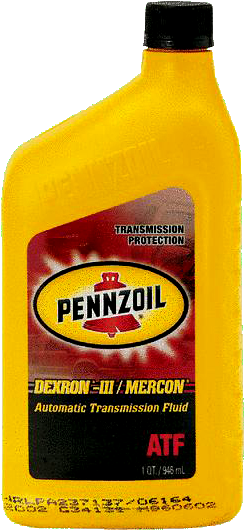
Like most drivetrain components, an automatic transmission generates friction and needs lubrication to prevent wear. Automatic Transmission Fluid (also called ATF) is typically colored red, pink, or green to distinguish it from motor oil and other fluids typically found in the vehicle, which also makes leaks easier to distinguish. Unlike motor oil, transmission fluid is checked while the engine is running. ATF plays a vital role in the torque converter, since none of the parts inside of it actually make contact; fluid viscocity helps the engine side drive the impeller.
ATF is also used as a hydraulic fluid in some power assisted steering systems, as a lubricant in some 4WD transfer cases, and even in some modern manual transmissions. Continuously variable and dual-clutch transmissions use an even-more-specialized fluid.
Most ATF types consist of 85 to 90% base oil and 10 to 15% additives. The temperature demands placed on the base oil have increased dramatically over the years, requiring good flow at low temperatures while being able to withstand the heat of high stress front wheel drive systems. Many older formulations included zinc as an additive, but just as in motor oils, it has been phased out in recent years.
ATF Types
Unlike motor oil which is generally the same across all vehicle brands and manufacturers, ATF has a different type for almost every automotive group, and even those that can be separated by generation and transmission model.
Almost all ATF produced today is synthetic, but many older formulations used to be natural oil-based fluids. Some high-end synthetic ATFs can handle a wide range of applications, too.
- ATF+4 - Most Dodge, Jeep, and Chrysler
- MERCON V - Most Ford, Mercury, Lincoln
- MERCON LV - Some Ford (DuratecHE), Mazda in Europe or Asia
- DEXRON VI - Most GM and pre-2004 Toyota products, some Ford applications
- ATF DW-1 - All Honda and Acura (except CVT)
- SP-III - All Hyundai, Mitsubishi and Kia (except CVT and dual clutch)
- Matic S, Matic K, Matic D - Jatco transmissions, used in Nissan and Subaru vehicles
- Toyota ATF-WS - All 2004 and later Toyota including hybrids
Modern ATF Types/Uses
Warning: Always check with your owner's manual, dealer, mechanic, or other source to verify that you are getting the right fluid for your vehicle. Using the wrong fluid may damage your transmission.
Previous Formulas
From the 1950s through most of the 1970s, AT fluid contained whale oil. However, due to emission regulations and the need for better fuel economy, engines were designed to operate at higher temperatures which the whale oil couldn't cope with, and had to be replaced with new formulations such as DEXRON.
- Nitrogen - 0.9% (anti-wear additive)
- Sulfur - 0.55% (FM and anti-wear)
- Phosphorous - 0.3% (anti-wear additive)
- Zinc - 0.23% (anti-wear additive, anti-oxidant as ZDDP)
- Boron - 0.16% (detergent and anti-wear additive)
- Calcium - 0.05% (detergent/dispersant, tbn base chemistry)
- Magnesium - 0.05% (Detergent and base chemistry)
- Barium - various% (used as particlate control)
Chemicals in Automatic Transmission Fluid
The key to some of these additives are balancing the acids and bases, so that the fluid as a whole is PH neutral, or close to it. For example, calcium and magnesium are base materials on the PH scale.
MERCON (all grades) tends to have more nitrogen and phosphorous than other ATFs.
How to Change the Automatic Transmission Fluid
In this video, ChrisFix explains how to change automatic transmission fluid.
Flammability
ATF is quite flammable; not as flammable as gasoline, but much more flammable than motor oil. It is possible to ignite with a spark, so open containers of ATF are dangerous.
Slips
ATF is extremely slippery and poses even more of a slipping hazard than engine oil. Spills should be cleaned up immediately, and note that it leaves behind a film that can still be slippery after the fluid appears to be cleaned up.
